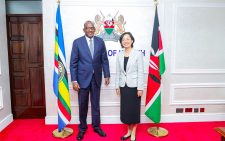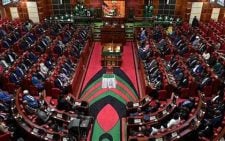Moi’s enchanting style and fine sense of fashion

Murimi Mutiga @murimimutiga
Daniel Moi, independence Kenya’s second president who passed away on Tuesday morning, will be remembered for his meticulous eye for fashion.
His well-matched sharp suits, ties and shoes portrayed him as a man who cared about his looks. To his aides, he was a teacher of good grooming.
Those who worked under him say during his reign and even in retirement, Moi wore “simple, but classic clothes that depicted the status of a Head of State”.
Former State House Comptroller Franklin Bett yesterday said Moi knew that image was everything and endeavoured to depict the image of a Head of State and to be seen to be serious.
Bett said Moi never wore any specific designer suit, but had a taste for nice and smart clothing.
The former minister said Moi mostly imported his clothes from Europe and his African attires were made in Nairobi and would often times be heard saying he wanted to be seen as serious because he was the Head of State.
“Whenever we went out of the country, we would accompany him for shopping.
He would select and tell us to get the clothes for him, his sons would help him select the best suits. They seemed to know their father’s sense of style,” he says.
Four sets of wardrobes
The children would then select which suit he would wear for the day, pointing to Moi’s close bond to his children.
Moi’s biographer Andrew Morton from the UK seems to support this disclosure when he notes in his Moi: The Making of An African Statesman book, that the former Head of State had all his suits directly imported from British tailor Saville Row in London.
He had four sets of wardrobes, one at State House (Nairobi), another at his Karbanet Gardens (Nairobi), a third one at his farm home in Kabarak and a mobile one.
Each of the wardrobes was filled with suits and a variety of African outfits. Bett says Moi had a special liking for deep grey suits.
“He had two colours for his shoes. He would either put on black or dark brown shoes, however, he had many pairs of slip-on shoes on his racks,” he added.
“He knew how to dress for every occasion; official, ceremonial and even dinner, this he did with the help of his children who played a big role in his grooming,” said Bett, adding that the suits were mostly worn while attending State or church functions.
He wore the short-sleeved shirts while at the Coast and when going for field events like harambees, launching projects or tree-planting,” the former MP recalled.
He says the house-keeping department at the State House would ensure all his clothes were clean and ironed at all times, ready for the occasion.
“On national occasions or when privy to the presidential diary, Moi’s children helped the house keeping officers plan for his dressing,” he added.
However, Bett says Moi was a humble African man who dressed smart, but not lavish clothing.
Travelled with wardrobe
His suits were never complete without a fresh lapel flower. “The roses were part of his trademark, they put a fresh rose everyday and these flowers were picked every morning at the State House, Kabarnet gardens of his rural home in Kabarak. We never used to buy the lapel flowers, the gardens were given utmost care and tending,” Bett recalls.
The former head of State would never leave for any meeting without one on his lapel and he would never travel without making sure his traveling wardrobe was in order and he had the right clothing.
Moi’s trademark knobkerrie (the famous Fimbo ya Nyayo) was also the unmistakable baton of authority.












